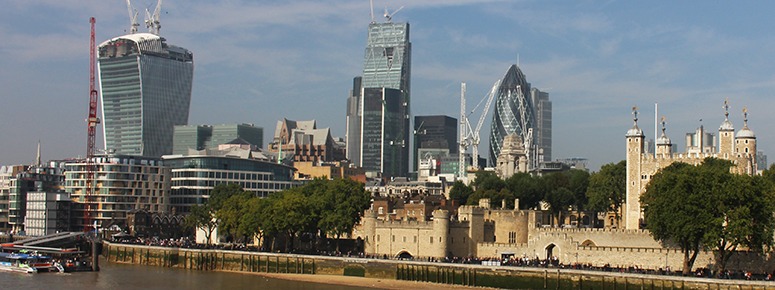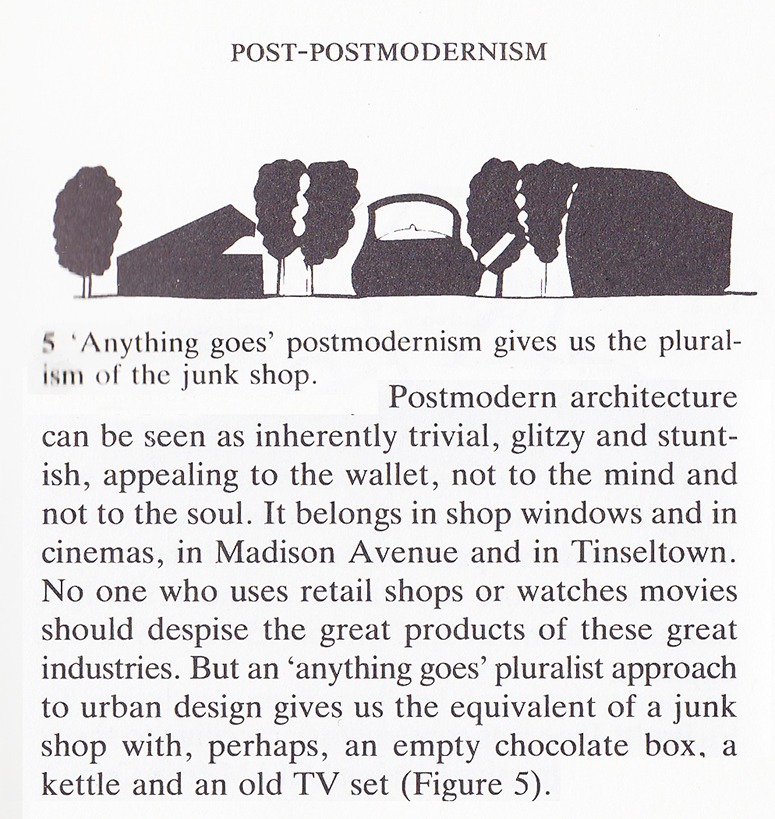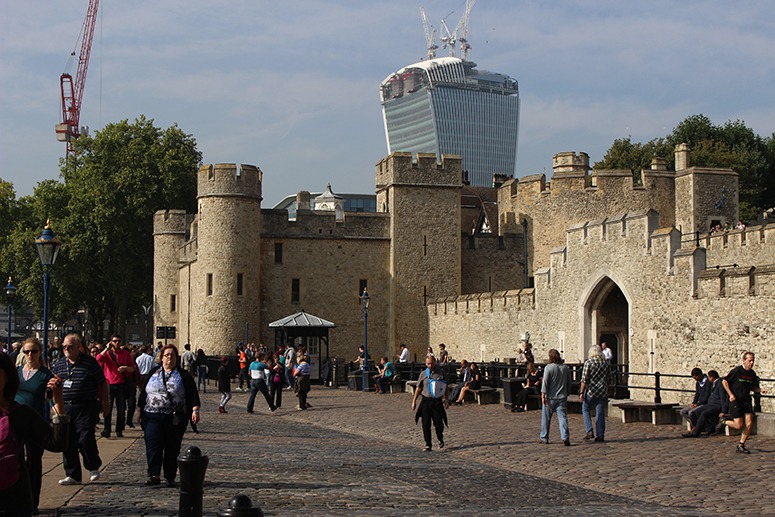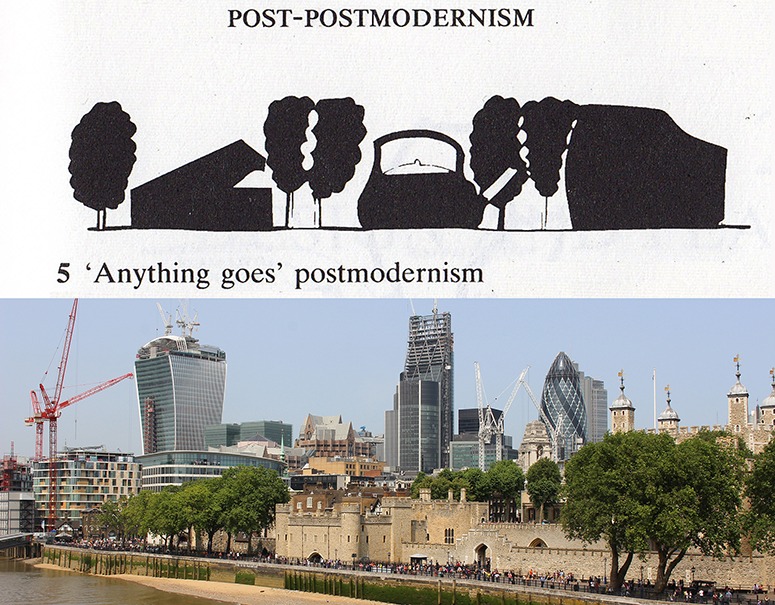
Junk Urban Landscape: the Walkie Talkie, the Cheesgrater and the Gherkin are waiting for The Kettle

Postmodern urban landscape design
The words and image (from City as landscape p. 6) were published in 1996. Sadly, I forgot that most designers look at books only for their pictures. Nor did I imagine that London’s designers would see my cartoon as the latest hot trend in urban design. Tragically, as you can see from the 2013 photograph the City of London (above, top), they are hell bent on building the cartoon. But I WAS JOKING. It was not a design proposal. I did not want it to be built. I regret that it is being built. I APOLOGISE TO LONDONERS AND TO LONDON’S URBAN LANDSCAPE. I should have listened to my grandfather: “Take care with whom you joke”.
Regarding the design of the Big Three newbies in the above photo, I think people are right to use simple domestic analogies when GIVING them NAMES. I have no particular dislike, or love, for the buildings. But why on earth didn’t their designers cooperate to compose a harmonious skyline? And why didn’t the town planners make any useful suggestions? And what did the Landscape Institute say about skyline policy? And what happened to form following function? And why are the cladding materials non-functional? They do not generate energy; they make no contribution to surface water management; they are unvegetated; there have no roof gardens; they do nothing for biodiversity. They probably won’t have any bike parking.
Environmentally, the Walkie Talkie may be the best of the three sisters. I can imagine a new urban quarter looking more like mushrooms than matchboxes. The Walkie Talkie’s power supply will come from a natural gas fuel cell. The ‘cap’ of the fungus has both an indoor garden and an outdoor viewing terrace. Best of all, the south-facing curved facade concentrates the sunlight so that pedestrians can fry eggs on the pavement.
Richard Rogers’ Cheese Grater was so-named by the City of London’s chief planner. He recounts that ‘When I first saw a model of the building, I told Richard Rogers I could imagine his wife, Ruthie, using it to grate parmesan. I don’t think he was too happy, but it stuck.’ The developers did not want their building to be wedge-shaped. It cost them a lot in floorspace and was done to lessen obstruction to views of St Paul’s Cathedral. To me, the views of St Paul’s which matter are those from the Thames – so I think this was an insufficient reason for a cheesy design. Pun intended: cheesy also means ‘Trying too hard, unsubtle, and inauthentic’. And why worry so much the relatively modern cathedral when the Walkie Talkie has such an unfortunate impact on a building of much more historical, architectural and landscape significance: the Tower of London? (see below)

The Walkie Talkie towers over the Tower of London
.
British people care about skylines but the official debate is mostly about the more limited topic of ‘high buildings’. Height is important but it is only one aspect of scenic composition. Wiki has this article on Composition and About.com has a list of The 8 Elements of Composition in Art:
Unity: Do all the parts of the composition feel as if they belong together, or does something feel stuck on, awkwardly out of place?
Balance: Having a symmetrical arrangement adds a sense of calm, whereas an asymmetrical arrangement creates a sense of unease, imbalance. (See example)
Movement: There many ways to give a sense of movement in a painting, such as the arrangement of objects, the position of figures, the flow of a river. (See example
Rhythm: In much the same way music does, a piece of art can have a rhythm or underlying beat that leads and paces the eye as you look at it. Look for the large underlying shapes (squares, triangles, etc.) and repeated color. (See example)
Focus (or Emphasis): The viewer’s eye ultimately wants to rest of the “most important” thing or focal point in the painting, otherwise the eye feels lost, wandering around in space. (See example)
Contrast: Strong differences between light and dark, or minimal, such as Whistler did in his Nocturne series. (See example)
Pattern: An underlying structure, the basic lines and shapes in the composition.
Proportion: How things fit together, big and small, nearby and distant.
I would like to see these principles applied in the composition of skylines but they relate only to aesthetic matters. In accordance with Vitruvius, we should be think about Commodity and Firmness, as well as Delight.
Here is a selection of links to pdf documents dealing with High Buildings and Skyline Policy in the UK. Most of them concentrate on the narrow issue of high buildings:
- Greater London Authority GLA 2001 Interim strategic planning guidance on tall buildings, strategic views and the skyline in London [This report was issued by Ken Livingston. It was based on the 1998 London Planning Advisory Committee LPAC High Buildings and Strategic Views in London but watered down. Ken was soft on high buildings]
- House of Commons report on Tall Buildings (2001-2) has a very good history of high buildings policy in the UK and much expert opinion on the subject
- Chapter 4 of Boris Johnson’s London Plan 2008 dealt with Tall and Large Scale Buildings. I am unsure whether this also forms part of the 2011 London Plan. Boris is said to be much softer than Ken on high buildings.
- The City of Edinburgh Skyline Study ( Colvin & Moggridge, Landscape Consultants, 2010) exemplifies the type of skyline study London should have. But conservation is not enough. We need imaginative contingency plans for the changes which MAY affect to London’s urban scenery and skylines.
Draft policy statement on skyline landscapes and tall buildings (also called high buildings or skyscrpers)




